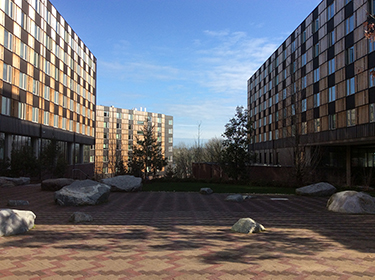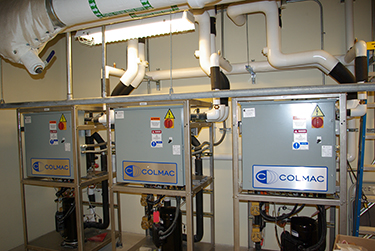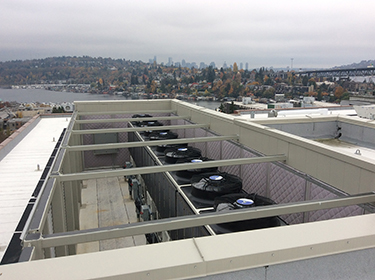|
Subscribe / Renew |
|
|
Contact Us |
|
| ► Subscribe to our Free Weekly Newsletter | |
| home | Welcome, sign in or click here to subscribe. | login |
Architecture & Engineering
| |
 |
April 15, 2021
Sustainable student housing building design for higher education
Rushing

Vander Mey
|
Sustainable building design for student housing is critical to the growth of local universities that have aging facilities, limited state funding for new housing, and that are trying to attract the best and brightest young students from around the world. Over the past 10 years, Rushing has had the opportunity to work on many higher education student housing projects in western Washington. All the projects were highly focused on minimizing energy usage, reducing greenhouse gas emissions, reducing water usage and reducing long-term maintenance costs, while maximizing amenities for the students.
The most recent phases of the University of Washington North Campus housing expansion include four new student housing buildings along Denny Field (McCarty, Madrona, Willow and Oak halls). These buildings achieved a LEED NC gold rating. The building LEED energy models demonstrate a 42% reduction in site energy consumption compared to the ASHRAE 90.1 baseline. By using heat recovery and heat pump systems, the projects reduced natural gas consumption by two-thirds.
Many of the key measures used to meet these sustainability goals involve the mechanical, electrical, plumbing and lighting systems. Some measures were simple and others much more complicated. Each of the measures were thoroughly vetted with the design teams and many tested with various student groups on campus in existing buildings prior to implementing in the new construction projects. Below is a summary of a few of the key measures.
The residential units in most of these buildings use electrical resistance baseboard space heaters and do not have mechanical cooling. The efficient thermal envelope and tight air barrier design help to minimize the space heating loads, but the push-for-heat thermostats provide the optimization to reduce energy usage in student rooms. These simple thermostats allow occupants to set the space heating temperature. Once set, the thermostat allows heat for two hours then automatically sets back to 66 degrees. If the temperature is not set for another 48 hours, the thermostat automatically sets back to 55 degrees. This allows most of the building to setback without any facility staff adjustments over winter break while maintaining freeze protection.
King Electric developed the latest version of this thermostat specially for the project.
Domestic hot water is a significant portion of the energy and water usage for student housing buildings, contributing to 25%-35% of annual energy usage mostly due to the heavy use of showers. The North Campus housing projects, after testing many shower heads (including personal in-home testing by the Housing & Food Services capital planning and sustainability manager), settled on an ultra-low-flow shower head that outperformed many other shower heads with higher flow rates. The Bricor Eco-Mi$er 1.06-gallon-per-minute shower head helped to reduce domestic water usage by more than 50% over a code-compliant building, achieving a 58% reduction in flow.
Other measures implemented were not as simple but will provide substantial energy and carbon emissions savings for the student housing projects over the coming years. These include central heat recovery systems to transfer “waste” heat from commercial kitchen refrigeration systems and electrical rooms that utilize water-to-water heat pumps over to domestic hot water production. This concept can be applied within a building or even across multiple buildings, allowing heat from dining and commercial kitchens to reduce the use of boilers in adjacent buildings.
For the UW North Campus housing project, the integrative design process and life-cycle cost analysis study resulted in shared central plant equipment between the buildings for only the heating systems. Central systems for multiple buildings did not pencil for the cooling systems based on the low summer occupancies. The residential areas are supported by a wide range of common areas throughout the various buildings. These include student meeting rooms, study centers, maker labs, chemistry labs, gaming centers, cafes, dining cafeterias and commercial kitchens. Mixing these commons areas within the same structures as the residential housing allows for greater energy exchange, providing significant energy and greenhouse gas emission reductions. For example, heat is recovered from the more energy-intensive commercial kitchen common areas in Willow Hall and shared with the residential uses in Willow, McCarty and Madrona halls.
West Campus buildings (Lander, Maple and Terry halls) provided a unique energy exchange opportunity for the UW central cooling water system. This system operates to provide chilled water for cooling during the summer months but during other times of the year acts as an energy exchange loop. These three buildings provided an opportunity to “harvest” heat from other buildings on the central cooling water loop that are cooling server rooms and electrical rooms with internal loads throughout the campus.
In addition to air-to-water heat pumps that supplement the natural gas boiler systems, water-to-water heat pumps and energy recovery coils are used to provide heat for the domestic hot water systems and commercial kitchen make-up air units.
While many other design ideas and measures were studied along the way, the systems serving residential units remained simple throughout the evolution of the design. With the recently enacted 2018 state and city energy codes requiring energy recovery ventilation for Group R-2 dwellings and sleeping units, this presents a new challenge for student housing projects in Washington. These energy and mechanical code requirements provide the framework to build higher-performance buildings. The energy recovery ventilation systems have the added advantage of supplying fresh tempered and filtered air to each student housing unit. The added challenge will be finding ways to cost-effectively implement these requirements in the student housing projects that are constructed to operate very differently than market-rate apartment buildings.
Rushing is excited about the significant impact these past and future housing projects will have on the lives of our state’s higher education students, providing a sustainable and comfortable environment to live, learn, work and play. We look forward to implementing these sustainable design measures on future projects.
Eric Vander Mey has been the principal in charge at Rushing for numerous student housing projects for the University of Washington (Seattle and Bothell campuses) and Western Washington University.
Other Stories:
- Seattle’s U District housing boom: is there room for it?
- Sourcing regional materials for higher ed
- New design requires thoughtful programming
- Early-stage design helps Hermanson with UW center
- How to make master plans that work
- The post-pandemic educational learning curve
- The evolution of campus, a new normal for higher education
- The evolving building delivery models at higher education institutions





